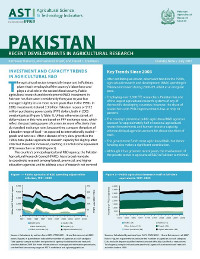Authors:
Kathleen Flaherty, Muhammad Sharif, David J. Spielman
Year:
2012
Publisher
International Food Policy Research Institute (IFPRI); and Pakistan Agricultural Research Council (PARC)
Back to:
Agricultural R&D investment in Pakistan increased during 2000–09, albeit at an irregular pace. Pakistan has one of the largest agricultural research systems among developing countries, employing over 3,500 FTE researchers. However, based on a number of indicators, Pakistan appears to be falling behind other South Asian countries. As of 2009, agricultural research spending did not match AgGDP growth, resulting in a weakening agricultural research intensity ratio of 0.21; the share of agricultural researchers holding PhD degrees remained low, at 18 percent; and, despite improvements at a number of institutes, overall employment of female researchers continues to be very low. Finally, private investment in agricultural research has grown but remained relatively small as of 2009.
These financial and capacity challenges have occurred at a time of institutional uncertainty. Spending and capacity patterns have fluctuated as agencies adjust to the devolution and reorganization of responsibilities across national, provincial, and local levels of government in response to the 18th Amendment to the country’s constitution. Provincial institutes have taken on a larger role in agricultural research, but questions remain as to whether they are resourced and structured to do so effectively.
This period of change has, however, offered opportunities to review existing structures and reassess research priorities. Whether the changes will yield advancements both in the system itself and in agricultural productivity remains to be seen.

